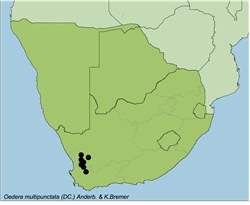Names and synonyms
Oedera multipunctata (DC.) Anderberg & Bremer
=Relhania multipunctata DC.
Type
Drege, Cedarbergen, at Honigvalei and on Kaudeberg, 900-1200 m (G-DC, G, L, P, S, W).
Derivation of names
Oedera = after George Christian Oeder (1728-1791), professor of Botany in Copenhagen, author of Flora Danica
multi- = much, many; punctatus = points
Diagnostic characters
Capitula in small clusters on long peduncles
Peduncles and young stems woolly-hairy
Leaves glandular -punctate
Leaf midrib not more prominent below than above
Ray floret lamina about as long as the involucral bracts
Description
A moderately branched shrub, up to c. 1 m high. Stems ascending-erect, tomentose, leafy, becoming glabrous and nude and marked with leaf-scars. Leaves alternate, spreading, � flat, mid-ribbed, narrowly obovate, 5-24 x 1-4 mm, young leaves laxly tomentose, becoming glabrous, distinctly glandular-punctate, acute-obtuse. Capitula 2-5 together in terminal cymes. Peduncles 3-15 mm long during flowering. Involucre narrowly cup-shaped, 2.5-6 mm wide. Involucral bracts 25-35, subequal, outer ovate, inner gradually longer and narrowly oblong, innermost linear and straight, up to 13 x up to 1.7 mm, innermost dorsally sparsely gland-dotted, acute. Receptacle flat-convex, paleate. Paleae canaliculate, subulate-linear or very narrowly spatulate, 8-12 mm long, apically 0.2-0.5 mm wide, dorsally gland-dotted, acute. Ray florets 6-11; tube 2.5-4 mm long, glandular; lamina narrowly elliptic, 5-10 x 1.3-2.5 mm, 4-veined. Disc florets 8-25, perfect; corolla 6-8.2 x 0.7-1 mm; tube glandular on upper half; stylopodium distinct. Cypselas angular with lateral ribs, linear, 4-7 x 0.5-0.8 mm wide, glabrous or sparsely glandular. Pappus crownlike, of � connate scales, up to 1.2 mm long.
Flowering time
Mainly from August to October.
Distribution
Around the Cederberg range and in surrounding areas towards Calvinia and southwards to the Swartruggens.
Known from about 15 specimens.
Habitat
Sandy and stony mountain slopes,
Notes
O. multipunctata is a usually tall species with slender capitula. It is related to O. sedifolia and O. resinifera. It differs from the former in having the capitula arranged in cymes and from the latter in the characters of the cypselas and leaves, which are distinctly glandular-punctate, narrowly obovate and not very glutinous as in O. resinifera.
References
ANDERBERG, A.A. & BREMER, K. 1991. Parsimony analysis and cladistic reclassification of the Relhania generic group (Asteraceae - Gnaphalieae). Annals of the Missouri Botanical Garden 78: 1061-1072.
BREMER, K. 1976. The genus Relhania (Compositae). Opera Botanica 40.
GOLDBLATT, P. & MANNING, J.C. 2000. Cape Plants. A conspectus of the Cape flora of South Africa. Strelitzia 9. SANBI.
HARVEY. 1865. Compositae in: W.H. Harvey & O.W. Sonder. Flora Capensis 3 (ed. 1). Hodges & Smith, Dublin.
KESTING, D. & CLARKE, H. 2008. Botanical names, what they mean. Wild Flowers of the Cape Peninsula, 3rd revised edition. Friends of Silvermine.
PHILLIPS.1940. The Flowering Plants of South Africa 20: t. 786
SMITH, C. A. 1927. Four interesting species of Compositae. Bothalia 2: 360-365.

_sml.jpg)
_sml.jpg)
_sml.jpg)
_sml.jpg)